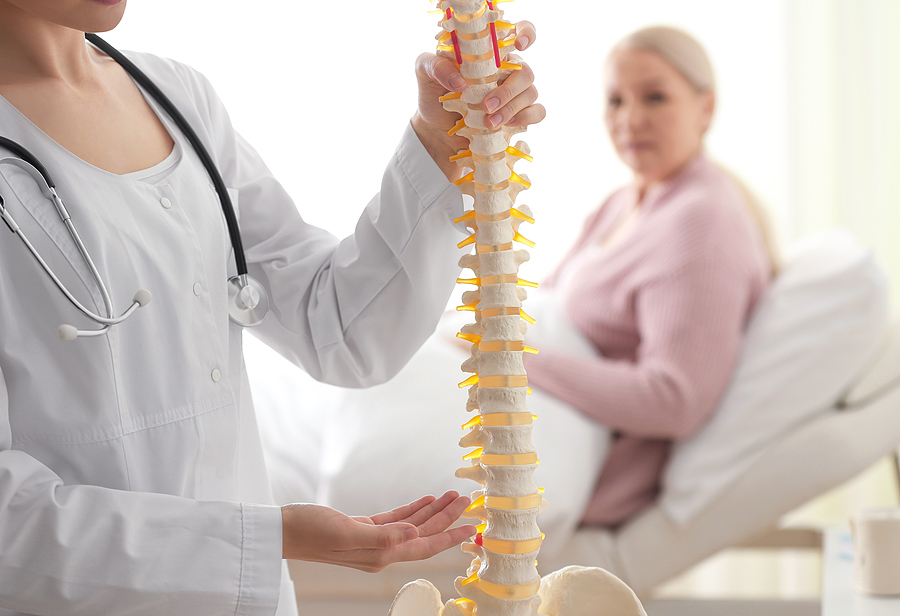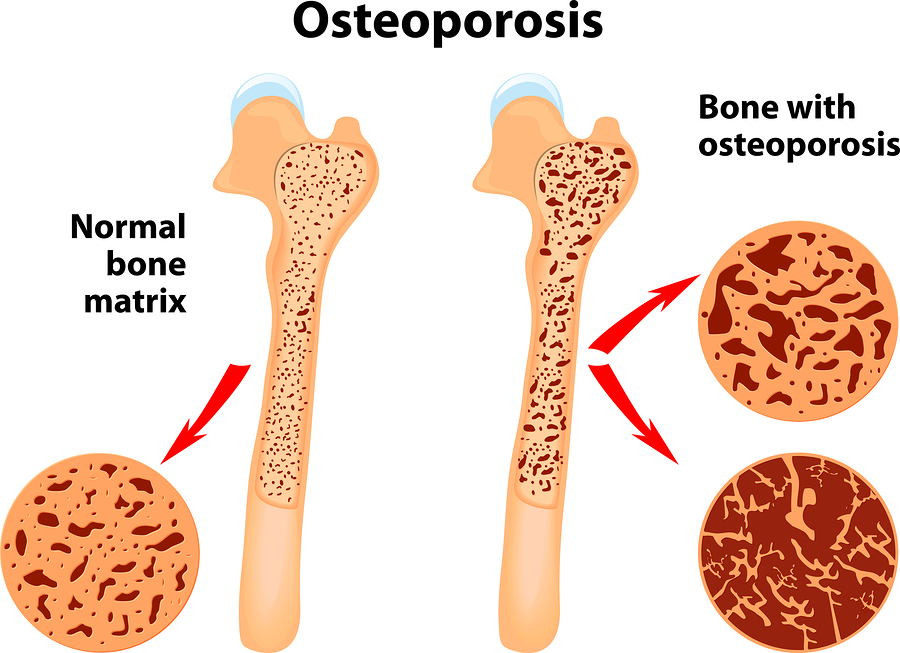Osteoporosis: 8 Tips to Prevent and Reverse Bone Loss in Women
 More than 200 million people are suffering from osteoporosis.
More than 200 million people are suffering from osteoporosis.
1 in 3 women over the age of 50 years and 1 in 5 men will experience osteoporotic fractures in their lifetime. (1)
Ladies, have you been told that you have osteopenia or osteoporosis? It’s important to keep your bones healthy, especially as you get older. You want to do all you can to decrease your risk of fractures. Today we’re going to share with you some tips to naturally protect your bones, and why you should avoid conventional osteoporosis drugs.
Make no bones about it, osteoporosis is rampant in America. Osteoporosis is a major public health problem that is characterized by low bone mass and increased susceptibility to fractures, primarily of the hip, spine, and wrist.(8) Although the disease is more prevalent among women, it does affect men, as well.
Osteoporosis and Osteopenia
Osteoporosis means porous bone. It occurs when the body loses too much bone, makes too little bone, or both. This results in bones becoming weak and increases your risk of a break. The risk of fracture from osteoporosis increases with age.(12) Osteopenia refers to bone density that is lower than normal, but not low enough to be considered osteoporosis. Your bones are weaker than normal but wouldn’t break easily.
Since bone loss occurs without symptoms, osteoporosis is often considered a “silent disease.” As deterioration of bone tissue mounts and disruption of bone architecture occurs, the bone becomes so weak that a relatively minor bump or fall causes a fracture or vertebrae to collapse. The resulting fracture may lead to loss of mobility and independence, with 25% requiring long term care. Fractures caused by either osteoporosis or low bone mass can lead to chronic pain, disability, as well as psychological symptoms, including depression. A woman’s risk of hip fracture is equal to her combined risk of breast, uterine and ovarian cancer. Unfortunately, approximately 24% of patients with hip fractures over the age of 50 will die in the year following the fracture.(12)
8 Tips to Prevent and Reverse Bone Loss in Women
1. Maintain Healthy Progesterone Levels – Progesterone promotes bone building. Research has found progesterone to be extraordinarily effective in reversing osteoporosis.(2,3) There is also evidence that progesterone may prevent osteoporosis. Progesterone stimulates osteoblasts and prevents bone loss. Studies indicate that progesterone, likely working through bone formation pathways, plays an active role in maintaining women’s bone and in osteoporosis prevention.(4) Research shows that transdermal progesterone had bone-sparing effects.(5)
2. Maintain Healthy Estrogen Levels – After menopause, the process of osteoporosis in women is accelerated due to deficiency of estrogen. Estrogen helps in the positive calcium metabolism and osteogenesis (the formation of bone). Menopause accelerates the bone loss to 2-5% per year, which may continue till 10 years.(6) Research showed that oral estradiol was effective in increasing bone mineral density in postmenopausal women with osteoporosis.(7)
3. Add Weight Bearing Exercise to Your Fitness Regimen – Research confirms that long-term weight-bearing exercise is an important factor in the regulation of bone mass and fracture prevention.(8) Physical activity, particularly weight-bearing exercise, is thought to provide the mechanical stimuli or “loading” important for the maintenance and improvement of bone health, whereas physical inactivity has been implicated in bone loss and its associated health costs.
Both aerobic and resistance training exercise can provide weight-bearing stimulus to bone. Nearly two dozen cross-sectional and longitudinal studies have shown a direct and positive relationship between the effects of resistance training and bone density. High-intensity resistance training has the added benefit of influencing multiple risk factors for osteoporosis including improved strength and balance and increased muscle mass.(9)
4. Eat 5-9 Servings of Organic Fruits and Vegetables Daily – Green leafy vegetables such as spinach and collard greens are especially good for maintaining healthy bones. Greater intake of fruits and vegetables was independently associated with a higher bone mineral density and a lower presence of osteoporosis.(10)
5. Avoid Soft Drinks – These drinks weaken bones. Research shows that intake of cola is associated with low bone mineral density in women. (11)
6. Optimize Vitamin D Levels – The high prevalence of vitamin D deficiency is a major factor in the low bone mineral density and poor bone health. Healthy lifestyle (diet, exercise and sunlight exposure) can have a major positive impact on the bone metabolism and bone health. (12) Calcium and vitamin D utilization in the optimization of bone health is often overlooked by patients and health care providers. The optimal standard of care for osteoporosis should encompass adequate calcium and vitamin D intake. (13)
Follow up with your physician to measure your 25-hydroxy vitamin D levels in order to assure that you’re within the optimal range. And on that note, get out and enjoy the sun! Natural sunlight is a great way to soak up vitamin D naturally.
7. Supplement with Calcium, Vitamin K2, and Magnesium – Calcium citrate and vitamin D3 have long been recognized as important and required nutrients for bone health and maintenance. The continuation of calcium and vitamin D in a patient with bone loss is critical for optimal care. Unfortunately, 90% of women may not be getting enough calcium and over 50% of women treated for bone loss have inadequate vitamin D levels. Prevention of falls with maintenance of bone health through adequate calcium, vitamin D, and physical activity represent the base of the pyramid for all individuals, including those with bone disease. (12) Research supports the current clinical and public health policy of recommending increased calcium intake among older women for fracture prevention. (14)
Vitamin K‘s effects extend beyond blood clotting to include a role in bone metabolism and potential protection against osteoporosis. Research indicates that vitamin K has a positive effect on bone mineral density and decreases fracture risk. (15)
A significant association has been found between bone density and the intake of magnesium, an essential micronutrient with a wide range of metabolic, structural and regulatory functions. Magnesium restriction promotes osteoporosis. Magnesium contributes to bone health, and about 60% of total magnesium is stored in the bone. Optimizing magnesium intake represents an effective and low-cost preventive measure against osteoporosis in individuals with documented magnesium deficiency. Magnesium is helpful intervention to maintain bone integrity. Magnesium deficiency contributes to osteoporosis directly by acting on crystal formation and on bone cells and indirectly by impacting on the secretion and the activity of parathyroid hormone and by promoting low grade inflammation. (16)
8. Avoid Smoking Cigarettes and Limit Alcohol Intake – Research findings further strengthen the evidence that cigarette smoking increases the rate of bone loss. Cigarette use is a risk factor for increased bone mineral density loss. Results suggest that smoking accelerates bone loss from the femoral neck and total body in the elderly and that less efficient calcium absorption may be one contributing factor.(17) Research clearly demonstrates that alcohol consumption compromises bone health and increases the risk of osteoporosis. Research suggests that in addition to alcohol, other lifestyle factors, such as tobacco use and poor nutrition, might result in a lower peak bone mass and increase the likelihood of bone fractures. (18)
Beware of Osteoporosis Drugs
Bisphosphonates are a common class of bone drugs used to treat osteoporosis. Brand names include Fosamax, Zometa, Reclast, Boniva, Actonel, and Aclasta, to name a few. Bisphosphonates were originally used in the textile, fertilizer and oil industries as corrosive agents. If that isn’t enough to make you think twice about putting them in your body, read on to learn how they actually weaken your bones.
Our body has a natural process to rebuild and rejuvenate our bones. Cells called osteoclasts are constantly breaking down old bone and osteoblasts are building new bone tissue to keep our bones strong. Bone drugs interrupt this natural process by slowing the bone breakdown process, inhibiting bone resorption and new bone growth. This process prevents the natural breakdown of bone, not allowing bones to rebuild to become stronger, thereby keeping bones weak and brittle.
Osteonecrosis of the Jaw, Femur Breaks, and Other Side Effects
Side effects of these bisphosphonate drugs include increased risk for osteonecrosis of the jaw (death of the jaw bone)(19). Research shows increasing recognition that use of bisphosphonates may be associated with osteonecrosis of the jaw. (20, 22) Research concludes that clinicians should be aware of atypical femoral fractures and their association with long-term bisphosphonate use. (21, 22)
Other side effects include gastroesophageal irritation, erosive esophagitis, severe suppression of bone turnover (impaired ability to repair fractures and increased fragility), nausea, dyspepsia, abdominal pain, gastritis, fever, myalgias, arthralgias, musculoskeletal pain, possible severe or incapacitating bone, joint and/or musculoskeletal pain, hypocalcemia, hyperparathyroidism, esophageal cancer, ocular inflammation (uveitis, conjunctivitis, episcleritis, scleritis), ocular pain, photophobia, and atrial fibrillation. (21)
Before you turn to potentially harmful drugs such as Fosamax, look for natural alternatives that work with your body’s natural pathways instead.
Bone Scan
The best way to find out if you have osteoporosis or osteopenia is to get a bone mineral density test. At Hotze Health & Wellness Center, we use a Hologic DEXA scan for diagnosing bone density. It is the preferred method of testing. DEXA (Dual Energy X-Ray Absorptiometry) scan is the most acceptable modality worldwide for the diagnosis and quantification of osteoporosis.(21) DEXA scan technology uses a very low dose of X-ray to measure the bone density at your hip and spine. It’s a simple and quick test that literally takes just minutes! It is ideal for all women and men 40 and over to have a baseline study. Early diagnosis and treatment may significantly reduce the risk of possible fracture.
Watch as Dr. Hotze shares how to naturally prevent bone loss:
Start taking action today to protect your bones. Remember, your hormones play an integral role in both the building of new bone and the removal of old bone. Evaluate the status of your hormone levels by taking our symptom checker to see if you have any of the symptoms of hormonal imbalance. Hormone replacement therapy has a positive effect on bone development. (17)
Call our Wellness Consultants today for a complimentary consultation at 281-698-8698. It will be our privilege to serve you!
Related Content
20 Amazing Benefits of Vitamin D
What Every Woman Should Know About Menopause Treatment
Research
1. An Overview and Management of Osteoporosis
2. Is Natural Progesterone the Missing Link in Osteoporosis Prevention and Treatment?
3. Osteoporosis Reversal with Transdermal Progesterone
4.Progesterone and Bone: Actions Promoting Bone Health in Women
5. Soymilk or Progesterone for Prevention of Bone Loss – A 2 year Randomized, Placebo-Controlled Trial
6. Overview of Research Studies on Osteoporosis in Menopausal Women Since the Last Decade
7. Dose Effects of Oral Estradiol on Bone Mineral Density in Japanese Women with Osteoporosis
9. The Effects of Progressive Resistance Training on Bone Density: A Review
13. The Use of Calcium and Vitamin D in the Management of Osteoporosis
14. Calcium for Prevention of Osteoporotic Fractures in Postmenopausal Women
15. Bone Health and Osteoporosis: The Role of Vitamin K and Potential Antagonism by Anticoagulants
16. Magnesium and Osteoporosis: Current State of Knowledge and Future Research Directions
17. Smoking Increases Bone Loss and Decreases Intestinal Calcium Absorption
18. Alcohol and Ofecting Osteoporosis Risk in Women
20. Long Term Bisphosphonate Therapy & Atypical Femoral Fractures: A Word of Caution
21. Adverse Effects of Bisphosphonates: Implications for Osteoporosis Management
22. Overview of Research Studies on Osteoporosis in Menopausal Women Since the Last Decade

